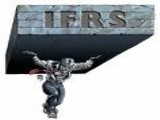IFRS for SMEs
29 May 2011
Definition of an SME
A small and medium sized entity (SME) is an entity that does not have public accountability and publishes general purpose financial statements for external users (such as the owners, creditors and bankers). Therefore, an SME is not defined by size but by its accountability to the public.A company will cease to be an SME if its shares are traded on a stock exchange.
Reasons for developing IFRS for SMEs
IFRSs were not designed specifically for listed companies. However, in many countries the main users of IFRSs are listed companies. Currently, SMEs who adopt IFRSs have to follow all the requirements, but not all SMEs take exception to applying IFRSs because it gives their financial statements enhanced reliability, relevance and credibility, and results in fair presentation. However, other SMEs will wish to apply simplified or different standards relevant to SMEs because some IFRSs are unnecessarily demanding and some of the information provided is not used by users of SME financial statements.
Some SMEs may also require different financial information as compared to listed companies. For example, expanded related party disclosures may be useful as SMEs often raise capital from shareholders, directors and suppliers, and directors often offer personal assets as security for bank finance. In addition, the cost of applying the full set of IFRSs may not be justified on the basis of user needs. The purpose and usage of the financial statements, and the nature of the accounting expertise available to SMEs will not be the same as for listed companies.
Therefore, the principal aim of developing an accounting framework for SMEs is to provide a framework which generates relevant, reliable and useful information. The standards should provide high quality and understandable accounting standards suitable for SMEs globally, and reduce the financial reporting burden for SMEs.
The downside
IFRS for SMEs was published to simplify financial reporting for SMEs that reflect user needs and cost-benefit considerations. As a result, it does not address certain topics as compared to the full IFRS due to the following:
- It provides significantly less guidance than the full IFRS.
- Many of the principles for recognising and measuring assets, liabilities, income and expenses in the full IFRS are simplified.
- Where the full IFRS allows choices of accounting policy, IFRS for SMEs only allows the easier option.
- Topics not relevant to SMEs are omitted.
- Significantly fewer disclosures are required.
Accounting treatments not allowable under IFRS for SMEs
Some of the accounting options in the full IFRS not included in IFRS for SMEs are as follows:
- Revaluation model for intangible assets and property, plant and equipment (Only the cost model is allowed).
- Proportionate consolidation in jointly-controlled entities (Jointly controlled entities can be measured at cost, fair value or using the equity method).
- Choice between the cost and fair value models for investment properties (Investment property whose fair value can be measured reliably without undue cost or effort shall be measured at fair value at each reporting date with changes in fair value recognised in profit or loss. All other investment properties should be measured at cost as per IAS 16 Property, plant and equipment).
- Choice between the full goodwill and proportion of net assets method (Only the proportion of net assets method is allowed).
Simplifications introduced by IFRS for SMEs
Some of the simplifications introduced by IFRS for SMEs in order to reduce the financial reporting burden on SMEs are as follows:
1. Financial instruments
- Financial instruments that pass the business model and contractual cash flow tests are measured at amortised cost.
- Investments in ordinary and preference shares are measured at fair value through profit or loss (FVTPL) if their fair values can be reliably estimated.
- All other financial instruments are measured at cost.
2. Goodwill and other intangible assets
- All intangible assets shall be considered to have a finite useful life and are therefore being amortised over their estimated useful life (or ten years if it cannot be estimated).
3. Investments in associates and joint ventures
- These can be measured at cost or using the equity method, but fair value must be used if there is a published price quotation.
4. Research and development costs and borrowing costs
- These cannot be capitalised and must be expensed.
5. Property, plant and equipment and intangible assets
- There is no need to review residual value, useful life and depreciation methods unless there is an indication that they have changed since the most recent reporting date.
6. Defined benefit plans
- All actuarial gains and losses are to be recognised immediately (in profit or loss or other comprehensive income).
- All past service costs are to be recognised immediately in profit or loss.
7. Consolidation of foreign subsidiaries
- Exchange differences on translation of foreign operations recognised in other comprehensive income are not to be reclassified to profit or loss on disposal of the foreign subsidiary.
Where the IFRS for SMEs does not specifically address a transaction, event or condition, an SME is required to look to the requirements and guidance elsewhere in the IFRS for SMEs dealing with similar and related issues. Failing that, the SME is required to adopt an accounting policy which results in relevant and reliable information. In doing so, it may look to the requirements and guidance in the full IFRS dealing with similar and related issues.







0 comments: